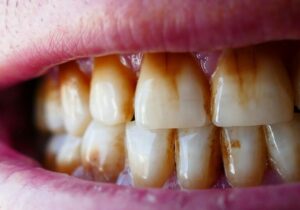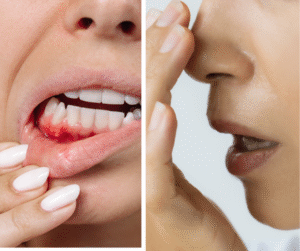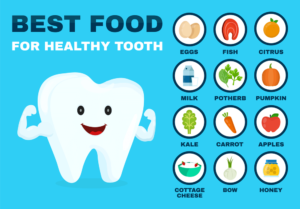Young adults are facing gum disease more than ever before — and the most shocking part? Many don’t even realize it until it’s already doing real damage.
Real-Life Wake-Up Call: Meet Sarah
Sarah was 27, full of life, thriving in her marketing career, and always the one with the brightest smile in the room. But something was quietly brewing behind that confident grin.
She often skipped flossing, brushed in a rush, and thought a little gum bleeding was “no big deal.”
Until one day at a routine dental checkup, she heard the words no young adult expects: early-stage gum disease. The diagnosis shocked her. What followed were painful deep cleanings, strict routines, and a lesson she’ll never forget.
“No one told me gum disease starts young,” Sarah says. “I thought it was an old person’s problem.”
Her story isn’t unusual — it’s becoming the normal.
Across the world, more and more young adults are developing gum disease, and many don’t even know it. Let’s look at why this is happening and what you can do to protect your smile.
Why Is Gum Disease Hitting Young Adults So Hard?
What’s Silently Harming Your Gums in Your 20s and 30s?
Without realising it, many young adults are putting their gum health at risk every single day. Let’s look at two of the biggest reasons:
1. Stress — The Silent Trigger
With all the pressure from college, work, and trying to stay afloat in today’s fast-moving world, stress has become a constant part of life for many in their 20s and 30s.
But here’s something most people don’t know — stress doesn’t just affect your mind, it affects your mouth too.
When you’re stressed for long periods, your body’s defence system weakens. That gives harmful bacteria the upper hand, and your gums become more likely to get inflamed or infected.
2. Rushed Oral Care from a Busy Lifestyle
Let’s be real — who hasn’t brushed their teeth in a hurry or skipped flossing before bed?
Between packed schedules and late nights, proper oral care often takes a back seat. But the problem is, those shortcuts add up.
Plaque (the sticky stuff that forms on teeth) can harden into tartar in just 24 to 72 hours. And once tartar forms, you can’t remove it at home — only a dental professional can.
3. Vaping and Smoking — Still a Big Problem
Many believe vaping is a “safer” option. But it’s still harmful, especially for your gums.
Vaping dries out your mouth, disrupts oral bacteria, and reduces blood flow, setting the stage for gum infections.
🚬 A study from NYU found vape users have similar bacteria patterns as heavy smokers. That’s no small risk.
4. Junk Food Is Hurting Your Gums More Than You Think
Late-night snacks, energy drinks, and fast food — they’ve become part of everyday life for most young adults. But what we eat plays a huge role in our gum health.
Sugary and processed foods give bad bacteria the fuel they need to grow. These bacteria attack your gums, causing inflammation and infection over time.
While junk food is feeding the problem, many young adults aren’t getting enough of the good stuff, like Vitamin C, Omega-3s, and fibre, which are key to healing and keeping gums strong.
5. Skipping Dental Visits? That’s a Risk
Many people think that if their teeth don’t hurt, there’s no issue. But that’s not how gum disease works.
It often starts quietly — no pain, no obvious signs — and by the time you feel discomfort, it’s already advanced.
Going in for regular cleanings helps catch gum problems early, remove tartar buildup, and save you from expensive and painful treatments down the line.
🚨 Signs Your Gums Might Be in Trouble
Think your gums are fine? Watch for these early warning signs — they often go unnoticed:
- Gums that bleed when you brush or floss
- Red, swollen, or sore gums
- Bad breath that won’t go away
- Gums pulling back from your teeth.
- Teeth that feel loose or move slightly when touched
❗ These are not “normal.” These are signs your gums are asking for help.
🛡️ How to Keep Your Gums Healthy (and Your Smile Safe)
The best part? Preventing gum disease isn’t complicated. Small, consistent habits can make a huge difference.
1. Brush and Floss — Properly
Not just a quick swipe — really take your time.
1. Brush twice a day for two full minutes.
2. Use fluoride toothpaste
3. Floss at least once daily — don’t skip it
4. Use an alcohol-free mouthwash to rinse away leftover bacteria.
🪥 Consider using an electric toothbrush — it removes significantly more plaque than a regular brush.
🥗 2. Eat What Your Gums Love
Food choices matter more than you think. Try to add:
1. Crunchy veggies like carrots and celery — they naturally scrub your teeth
2. Citrus fruits for Vitamin C — helps your gums heal and stay strong.
3. Omega-3 fatty acids from nuts, seeds, and fish — these reduce gum inflammation
4. And whenever you can, cut back on sugary treats and fizzy drinks
🚫 3. Say Goodbye to Vaping and Smoking — Your Gums Will Thank You
Even if you only vape or smoke occasionally, it’s still harming your gums every single time. These habits reduce blood flow, dry out your mouth, and create the perfect environment for gum infections to grow.
💡 The sooner you quit, the better. It’s not just your smile you’re protecting — it’s your heart, lungs, and overall health too.
🧘♀️ 4. Don’t Let Stress Take Over — It Affects Your Smile Too
Stress doesn’t just mess with your mood — it can mess with your mouth too.
When your stress levels are high, your body’s defenses drop, making it easier for gum infections to develop. That’s why managing your mental health is just as important as brushing your teeth.
Try simple things like:
- Taking deep breaths when you feel overwhelmed
- Going for a walk, doing light exercise, or stretching
- Spending time on something you enjoy — like drawing, music, or reading
🧠 Less stress means a stronger immune system — and that means your gums can stay healthy and protected.
🦷 5. Don’t Skip the Dentist — Even If You Feel Fine
Many people wait until there’s pain to see a dentist, but that’s one of the biggest mistakes.
Gum disease is sneaky — it often shows no symptoms until it’s serious. Regular checkups can catch problems early, clean out stubborn tartar, and keep your mouth in great shape.
A visit every 6 months can save you from painful procedures (and a big dental bill) later.
Another Real Story: Jason’s Early Action Saved His Smile
Jason, 25, had slight bleeding while brushing. He ignored it.
Luckily, his girlfriend convinced him to see a dentist.
Turns out, it was early gum disease — but since he caught it on time, basic cleanings and home care reversed the damage in just 6 months.“I’m glad I listened,” Jason says. “If I had waited, I might’ve lost teeth before 30.”
Your Gums Matter More Than You Think
Gum disease doesn’t show up with a big warning — it often starts quietly, especially when you’re young. You might not even notice it until the damage is already done.
But here’s the good news:
You don’t have to wait for a painful wake-up call like Sarah or a close call like Jason.
With just a few small changes — brushing properly, eating smart, and visiting your dentist on time — you can keep your gums strong and your smile bright for years to come.
Start now. Protect your smile. Protect your future. ✨
🪥 Want Simple, Daily Gum Care Tips?
Your smile deserves better — and we’ve made caring for it easier than ever.
👉 Click here to get quick, no-fuss oral care tips you can follow every day.
Your future self will thank you! 😄
FAQ
1. Why are more young adults facing gum disease today?
In short, lifestyle has changed, but awareness hasn’t caught up.
Today’s fast-paced routines mean many young people skip proper oral care — brushing too quickly, forgetting to floss, and visiting the dentist only when there’s pain.
Add to that high stress, sugary diets, and habits like vaping or smoking, and the perfect storm for gum problems forms. The result? Gum disease is starting earlier than ever, often silently.
2. Can stress really cause gum disease?
Yes, and it’s more powerful than most people realize.
When you’re stressed, your body releases cortisol, a hormone that weakens your immune system. This makes it harder for your body to fight off the bacteria that cause gum infections.
Also, stress can lead to poor habits like teeth grinding (bruxism), forgetting to brush, or stress-eating sugary foods — all of which make gum disease worse.
3. Is bleeding while brushing or flossing normal?
No, and that’s a big red flag people often ignore.
Gums should never bleed during brushing or flossing. Even a little bleeding means your gums are inflamed, often a sign of gingivitis, the earliest stage of gum disease.
Ignoring it means letting the infection get worse, which could lead to gum recession or even tooth loss.
4. Does vaping affect gum health like smoking?
Absolutely — and in some ways, it’s even sneakier.
Vaping dries out the mouth, reduces saliva (your mouth’s natural defense), and changes the balance of bacteria. This creates a breeding ground for gum infections.
Research from top dental schools has shown that vape users have similar levels of harmful oral bacteria as regular smokers, putting them at risk for the same gum issues.
5. How can I tell if I already have gum disease?
Watch out for these early signs:
- Gums that bleed easily
- Bad breath that doesn’t go away
- Swollen or red gum tissue
- Gums pulling away from teeth.
- Sensitive or loose teeth
- A strange taste in your mouth
Even one of these symptoms could mean your gums are in trouble. The earlier you act, the easier it is to fix.
6. Can gum disease be cured or reversed?
Yes, if caught early.
The first stage, gingivitis, can usually be reversed with better brushing, daily flossing, and a professional cleaning.
But if it progresses into periodontitis (a deeper infection), it becomes harder to treat and may cause permanent damage. That’s why early detection is key.
7. How often should young adults see a dentist?
Every 6 months is ideal — even if you don’t feel pain or see any issues.
Dental visits aren’t just about fixing problems. They’re about preventing them. Your dentist can spot early signs of gum disease, clean away tartar, and help you stay ahead of any trouble.
8. What kinds of foods help prevent gum disease?
Your gums need specific nutrients to stay strong and fight inflammation:
- Vitamin C (oranges, strawberries, bell peppers) helps heal gum tissue
- Omega-3s (salmon, flaxseeds, walnuts) reduce gum inflammation.
- Calcium (milk, yogurt, leafy greens) keeps the bones around your teeth strong.
- Crunchy veggies (carrots, celery) help clean teeth and increase saliva.
Avoiding sugary, processed foods also keeps harmful bacteria in check.
9. Is flossing really that important? Can’t I brush well?
Brushing is only part of the job. Even if you brush perfectly, your toothbrush can’t reach between your teeth, where bacteria love to hide.
Flossing removes food particles and plaque from tight spaces. Skipping it leaves up to 30% of your mouth dirty, which invites gum disease over time.
10. What happens if gum disease goes untreated?
Ignoring gum disease lets it grow quietly and dangerously.
- It can destroy the bone that holds your teeth in place.
- You may experience receding gums, loose teeth, or even tooth loss.
- It’s been linked to serious conditions like heart disease, diabetes, and stroke.
Gum health affects the whole body, not just the mouth. Treating gum disease early protects your smile and your long-term health.













